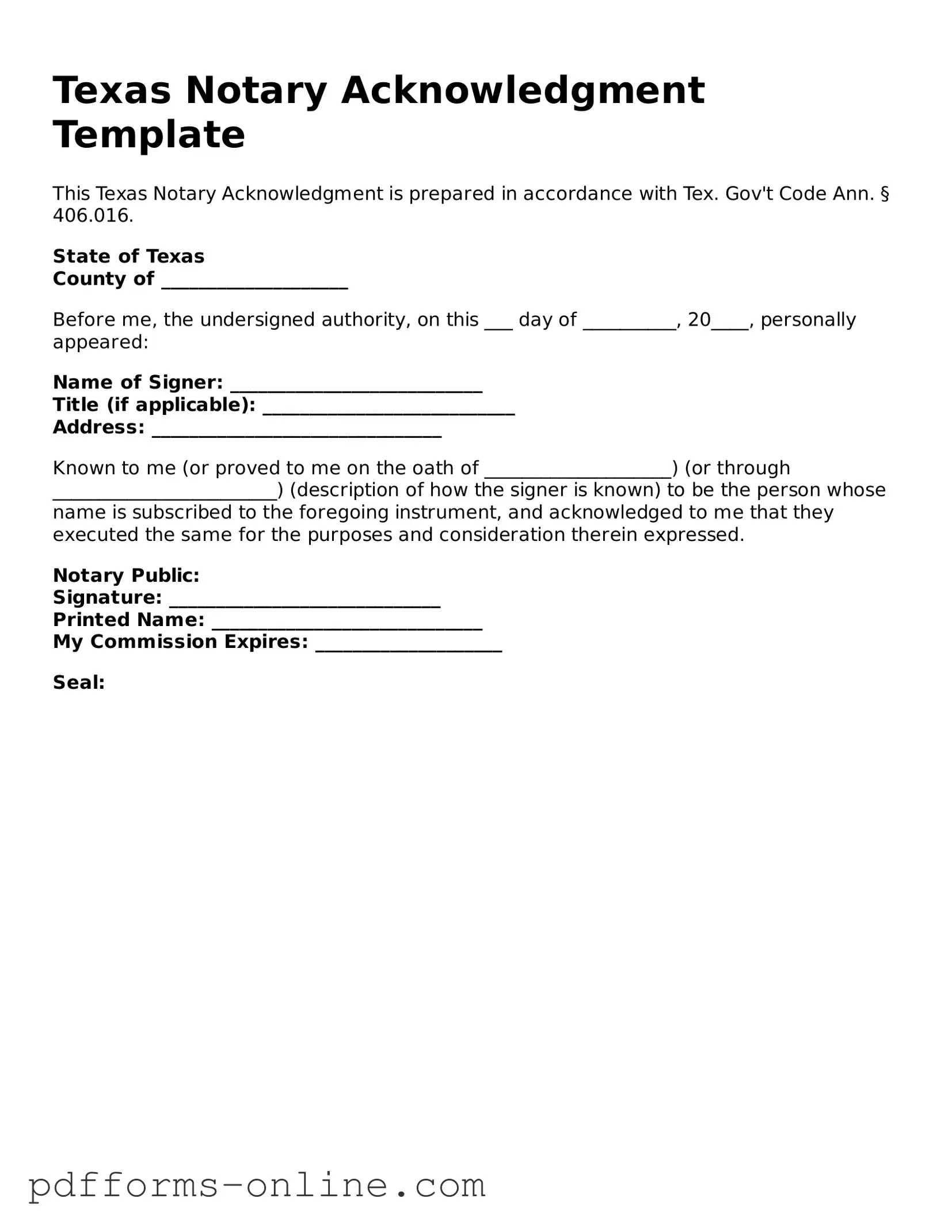The Texas Notary Acknowledgment form is similar to the Affidavit form, which is used to make a sworn statement. Both documents require the individual to affirm the truth of the information provided. In an affidavit, the signer swears to the accuracy of their statements before a notary public. This process serves to verify the identity of the signer and the legitimacy of the claims made, much like the acknowledgment form, which confirms that the signer willingly signed a document in the presence of a notary.
Another document that shares similarities with the Texas Notary Acknowledgment is the Power of Attorney (POA). A POA allows one person to act on behalf of another in legal matters. When creating a POA, the principal must sign the document in front of a notary public to ensure that the signature is authentic and that the principal understands the implications of granting such authority. Both forms aim to protect the parties involved by verifying identities and intentions.
The Deed is also comparable to the Notary Acknowledgment form. A deed transfers ownership of real property from one person to another. To be valid, the deed must be signed and notarized, which ensures that the signer is indeed the owner and is consenting to the transfer. The acknowledgment in this case serves a similar purpose as it confirms the identity of the signer and the voluntary nature of the transaction.
Another document that resembles the Texas Notary Acknowledgment is the Certification of Trust. This document verifies the existence of a trust and the authority of the trustee. When a trustee signs the certification in front of a notary, it provides assurance to third parties that the trustee has the legal authority to act on behalf of the trust. Like the acknowledgment, this process adds a layer of protection by confirming identities and intentions.
The Loan Agreement is another document that often requires notarization. When parties enter into a loan agreement, they may need to sign the document before a notary to verify their identities and ensure that they understand the terms of the agreement. This process is similar to the Texas Notary Acknowledgment, as both serve to authenticate signatures and affirm the voluntary nature of the agreements being made.
Similarly, the Lease Agreement can also be compared to the Notary Acknowledgment form. When landlords and tenants sign a lease, they may opt to have the document notarized. This step ensures that both parties are who they claim to be and that they are entering into the lease willingly. The notarization process adds an extra layer of security, much like the acknowledgment form does for other documents.
In the realm of legal documentation, understanding the nuances of each form is vital for ensuring clarity and protection during transactions. A Trailer Bill of Sale form specifically aids in formalizing the sale and transfer of a trailer, acting as a crucial protective measure for both buyers and sellers. To gain further insights into creating or obtaining this form, you can visit OnlineLawDocs.com, which provides valuable resources and templates tailored for this purpose.
The Bill of Sale is another document that bears resemblance to the Texas Notary Acknowledgment. This document is used to transfer ownership of personal property from one individual to another. Notarizing a bill of sale helps confirm the identities of both the buyer and the seller, ensuring that the transaction is legitimate. The acknowledgment process serves to validate the agreement and protect both parties involved.
Lastly, the Marriage License Application often requires notarization. When couples apply for a marriage license, they may need to have their signatures acknowledged by a notary public. This process verifies their identities and confirms that they are voluntarily entering into the marriage agreement. Similar to the Texas Notary Acknowledgment, this step helps ensure that all parties are acting in good faith and with full understanding of their commitments.
